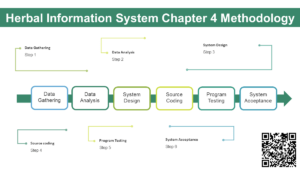Dental Management System in PHP
Introduction
Table of Contents
Managing a dental practice involves numerous tasks, from scheduling appointments and maintaining patient records to handling billing and invoicing. With the complexity of these operations, it’s no surprise that dental practices often face challenges in ensuring efficient and error-free management. However, there is a solution that can revolutionize the way dental clinics operate: the Dental Management System.
A Dental Management System is a comprehensive software solution designed to streamline the day-to-day operations of dental practices. It provides a centralized platform to manage appointments, maintain patient records, handle billing and invoicing, and even track inventory. By automating these processes, dental clinics can improve their efficiency, reduce errors, and enhance patient care.
One of the key technologies used to develop Dental Management Systems is PHP, a powerful scripting language widely used for web development. PHP brings a plethora of benefits to the table, making it an ideal choice for building robust and user-friendly systems. Let’s delve into the advantages of using a Dental Management System built with PHP:
- Improved Efficiency: With a Dental Management System in place, dental practices can say goodbye to manual appointment scheduling and paper-based record-keeping. PHP enables the development of intuitive interfaces that allow staff to efficiently manage appointments, update patient records, and access relevant information with just a few clicks. This automation saves time and effort, allowing dental professionals to focus on providing quality care.
- Reduced Errors: Manual data entry is prone to errors, leading to potential complications in patient care and billing. By utilizing PHP’s robust functionalities, a Dental Management System can enforce data validation and ensure accurate input. This reduces the risk of errors and enhances the reliability of patient records, ensuring that dentists have access to up-to-date and accurate information when making treatment decisions.
- Streamlined Billing Process: Billing and invoicing can be a tedious and time-consuming task for dental practices. However, with a Dental Management System built with PHP, generating bills and managing invoices becomes a breeze. The system automates the calculation of charges based on treatment codes, tracks outstanding payments, and provides detailed billing statements for patients. This not only simplifies the billing process but also improves cash flow management for the practice.
- Enhanced Patient Care: A Dental Management System built with PHP empowers dental professionals to provide better patient care. By having instant access to complete and accurate patient records, dentists can make informed decisions regarding treatment plans, allergies, medical history, and ongoing prescriptions. This comprehensive view of patient information ensures personalized care, improves communication, and enhances the overall patient experience.
The challenges faced by dental practices in managing appointments, records, and billing can be effectively addressed with the implementation of a Dental Management System built with PHP. The benefits are vast, ranging from improved efficiency and reduced errors to better patient care and streamlined billing processes. By harnessing the power of PHP, dental clinics can elevate their practice management to new heights, leaving more time for what truly matters – delivering exceptional dental care to their patients.
Key Features and Functionalities
A well-designed DMS built with PHP can significantly improve the day-to-day operations of your dental practice. Here’s a breakdown of some essential features and functionalities:
- Appointment Management:
- Seamless Scheduling: The system should allow patients to schedule appointments online (optional) or through the practice staff. This can include features like:
- Availability calendar for dentists and hygienists.
- Appointment booking with different time slots and durations.
- Online appointment confirmation and reminders via email or SMS.
- Efficient Management: Staff can manage appointments effectively with features like:
- Drag-and-drop scheduling interface for easy rescheduling.
- Patient appointment history with notes and treatment details.
- Integration with email or SMS platforms for appointment reminders.
- Patient Records Management:
- Centralized Database: The system stores comprehensive patient information securely in a central database, including:
- Demographic details (name, address, contact information).
- Medical history (allergies, medications, past procedures).
- Dental charts, X-rays, and other relevant documents (secure storage).
- Treatment plans with notes and progress tracking.
- Easy Access and Updates: Authorized personnel can access and update patient records efficiently, improving the flow of information and patient care.
- Billing and Invoicing:
- Streamlined Billing: The system simplifies billing by:
- Automatically generating invoices based on treatment plans and applied charges.
- Integrating with dental insurance providers for claim submissions (optional).
- Offering various payment options (cash, credit card) with secure processing (optional).
- Clear Communication: Generate detailed and easy-to-understand invoices for patients, outlining treatment details, costs, and insurance coverage breakdown (if applicable).
- Inventory Management (Optional):
- Stock Control: The system can track dental supplies and equipment inventory levels, including:
- Recording purchases and usage of various dental materials.
- Setting reorder points to ensure timely restocking and prevent stockouts.
- Generating reports on inventory usage and costs.
- Reporting and Analytics:
- Data-Driven Insights: The DMS can generate valuable reports on various aspects of your practice, such as:
- Appointment trends and scheduling efficiency.
- Treatment statistics and revenue generated by different procedures.
- Patient demographics and trends in treatment needs.
- Performance analysis of individual dentists and hygienists.
- Informed Decision Making: These reports and data visualizations empower you to make informed decisions about staffing, resource allocation, and service offerings.
By implementing these core functionalities in your PHP-based DMS, you can create a comprehensive system that optimizes your dental practice, improves patient care, and empowers you to focus on what matters most – your patients’ well-being.
Benefits of Using PHP for Dental Management Systems
Building a Dental Management System with PHP offers several advantages. Let’s explore the benefits of using PHP for developing Dental Management Systems:
- Flexibility and Scalability: PHP’s flexible nature allows for easy customization and scalability of the system. As dental practices evolve and grow, their management systems need to adapt to changing requirements. PHP’s modular approach enables developers to create flexible systems that can be customized to meet specific needs. The ability to add or modify features, integrate with other systems, and accommodate future enhancements makes PHP an ideal choice for scalable Dental Management Systems.
- Rich Ecosystem: PHP has an extensive and vibrant community, which means developers have access to a rich ecosystem of resources, frameworks, and libraries. The PHP community actively contributes to the development and improvement of PHP, ensuring a robust and constantly evolving language. Frameworks like Laravel, CodeIgniter, and Symfony provide pre-built components and tools that enhance development efficiency. Additionally, there are numerous libraries available for various functionalities, such as database interactions, form validation, and PDF generation. This vast ecosystem empowers developers to accelerate the development process and build feature-rich Dental Management Systems.
- Web-Based Accessibility: PHP facilitates the creation of web-based Dental Management Systems, enabling remote access and collaboration. With a web-based system, dental professionals can securely access patient records and manage appointments from anywhere with an internet connection. This flexibility allows for seamless collaboration among dental staff, even if they are located in different physical locations. Additionally, web-based systems eliminate the need for installing and maintaining software on individual devices, reducing IT infrastructure costs and simplifying system updates.
By utilizing PHP’s flexibility and scalability, leveraging the extensive PHP community, and harnessing the web-based accessibility it offers, Dental Management Systems can be developed to meet the evolving needs of dental practices. PHP’s versatility and the support of its community enable developers to create efficient and user-friendly systems that enhance the management of dental clinics, ultimately improving patient care and practice operations.
Development Process
Now that you’re convinced about the advantages of using PHP for your Dental Management System (DMS), let’s delve into the development process. Here’s a roadmap to guide you:
- Setting Up Your Development Environment
- Similar to the previous blog post: We’ll assume you’re using XAMPP for development. Refer to the “Water Billing System” blog post for detailed instructions on downloading, installing, and configuring XAMPP. This ensures you have the necessary components: PHP interpreter, Apache web server, and MySQL database server.
- Additional Considerations: You might want to consider using a version control system like Git to manage your code effectively, especially as your project grows.
- Database Design
The heart of your DMS lies in the database. Here’s a breakdown of some core tables you might consider:
- Patients: This table stores patient demographic information, medical history, dental insurance details, and potentially a field for storing dental chart images.
- Appointments: This table tracks appointment details like date, time, dentist/hygienist assigned, treatment planned, and notes.
- Treatments: This table defines various dental procedures offered, associated costs, and potential links to relevant dental codes for insurance purposes.
- Invoices: This table stores invoice information, including patient reference, date, treatment details, applied charges, and payment status.
Additional Tables (Optional):
- Inventory: This table can track dental supplies and equipment, including quantities, reorder points, and supplier information.
- Users: This table (with proper security measures) can manage user accounts for different staff roles (dentist, hygienist, receptionist) with varying access levels to specific functionalities within the DMS.
- User Interface and Functionality Development
This is where PHP shines! You’ll use PHP along with HTML, CSS, and potentially JavaScript to build the user interface (UI) and implement the functionalities of your DMS. Here’s a general approach:
- Planning the User Interface: Sketch out wireframes or mockups to visualize the layout and user flow for different functionalities like appointment scheduling, patient record management, and billing.
- Developing PHP Functionality: Write PHP code for key functionalities like:
- Connecting to the database to perform CRUD (Create, Read, Update, Delete) operations on data.
- Processing user input (e.g., scheduling appointments, updating patient records).
- Generating reports and invoices.
- Building the User Interface: Use HTML to structure the web page layout, CSS to style the interface elements, and potentially JavaScript to enhance user experience with interactive features.
Remember: Security is paramount. Implement proper user authentication and access control mechanisms to protect sensitive patient data. Utilize prepared statements in your PHP code to prevent SQL injection vulnerabilities.
Testing and Deployment:
- Thoroughly test your DMS to ensure functionalities work as expected and data is handled securely.
- Once satisfied, deploy the system to a web hosting platform accessible through the internet for your dental practice.
Screenshots
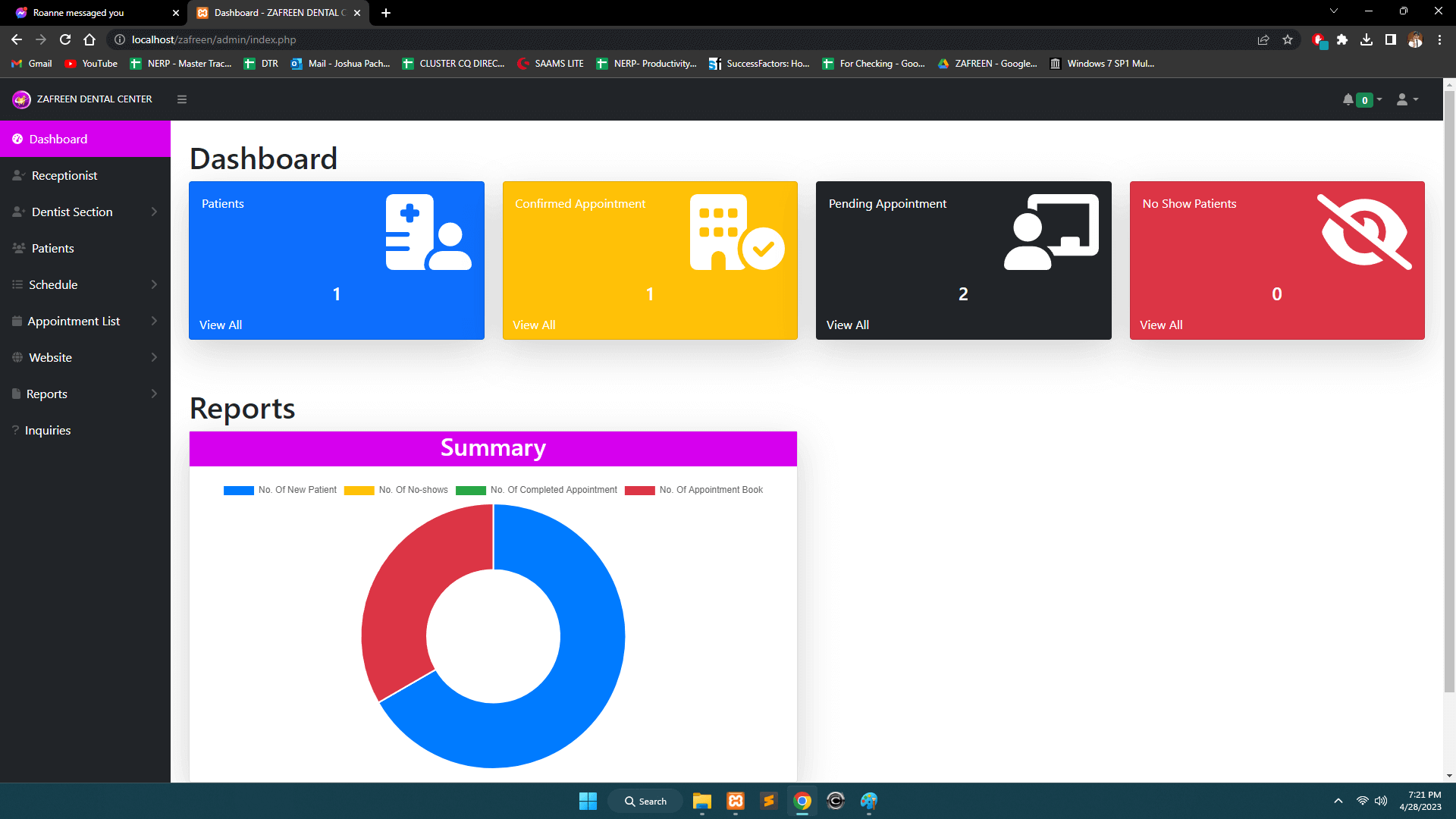
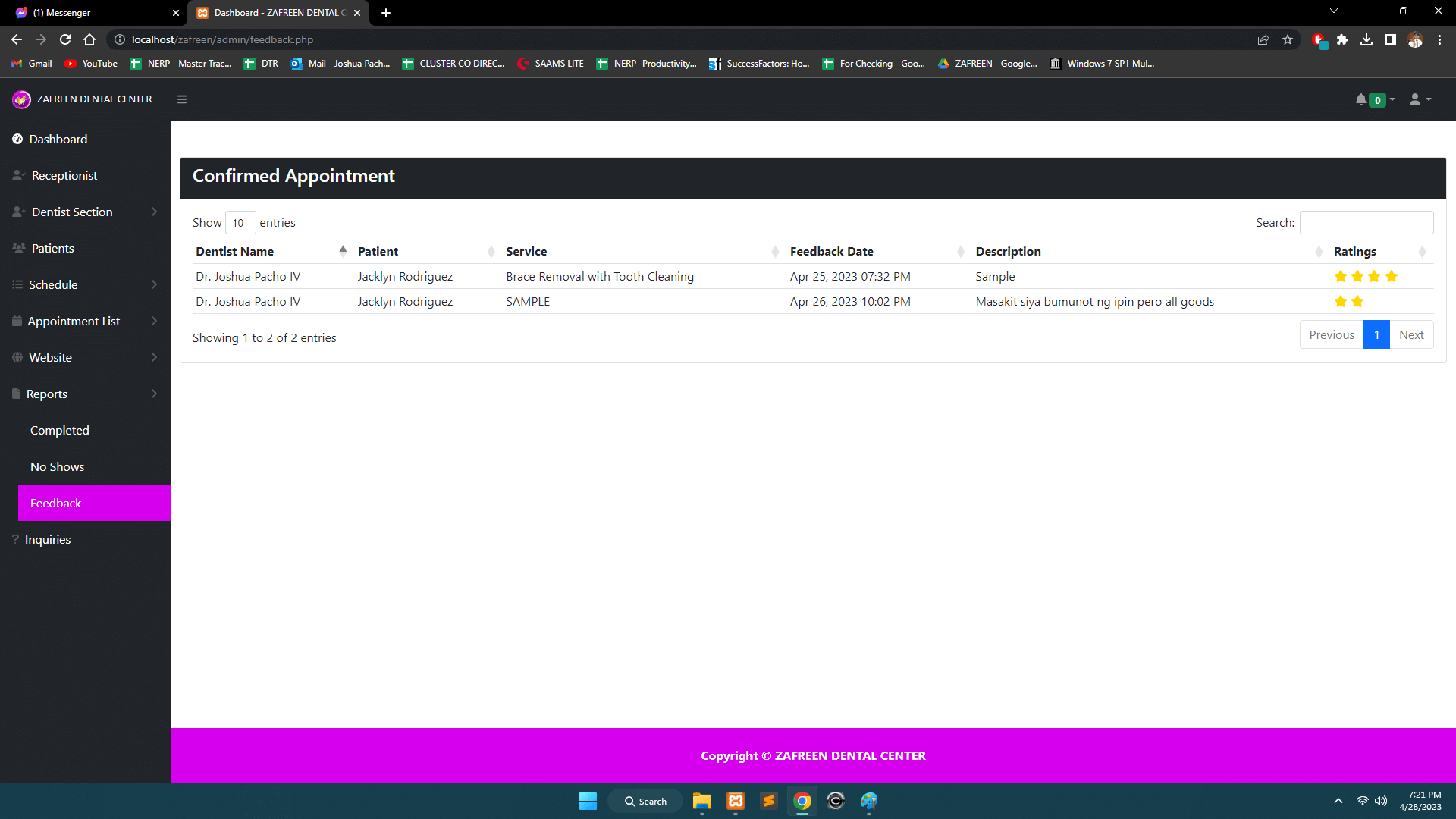
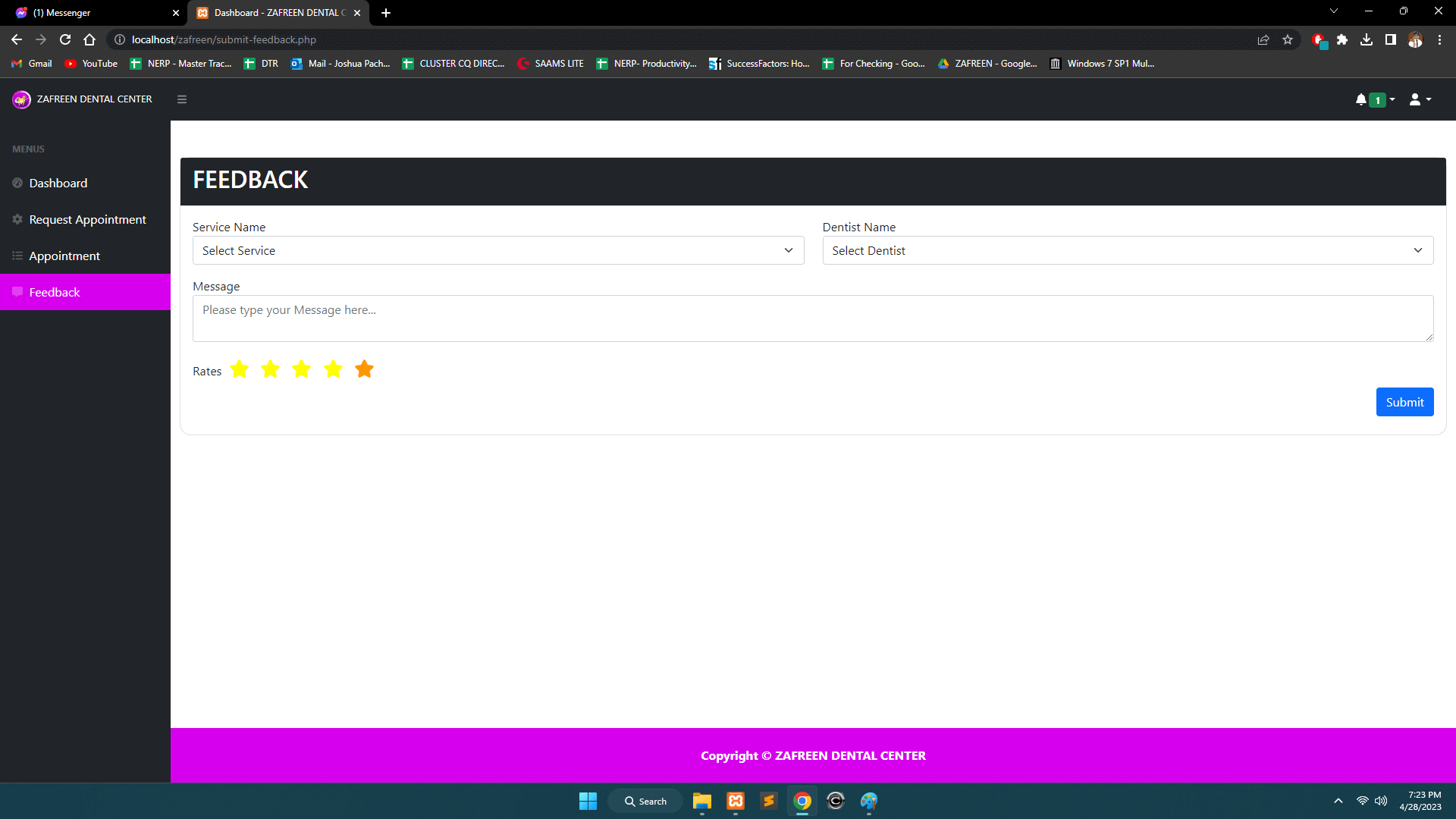
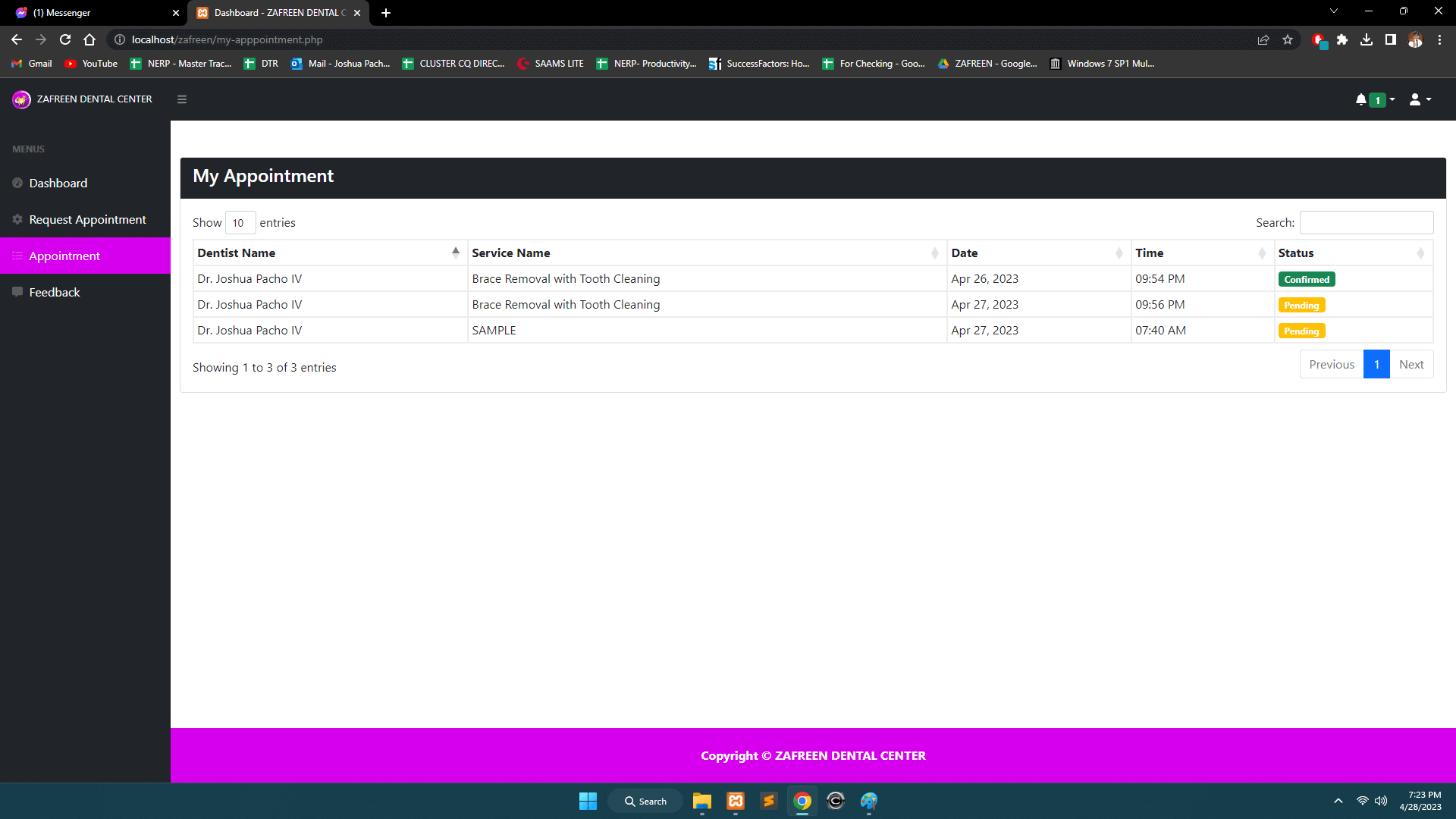
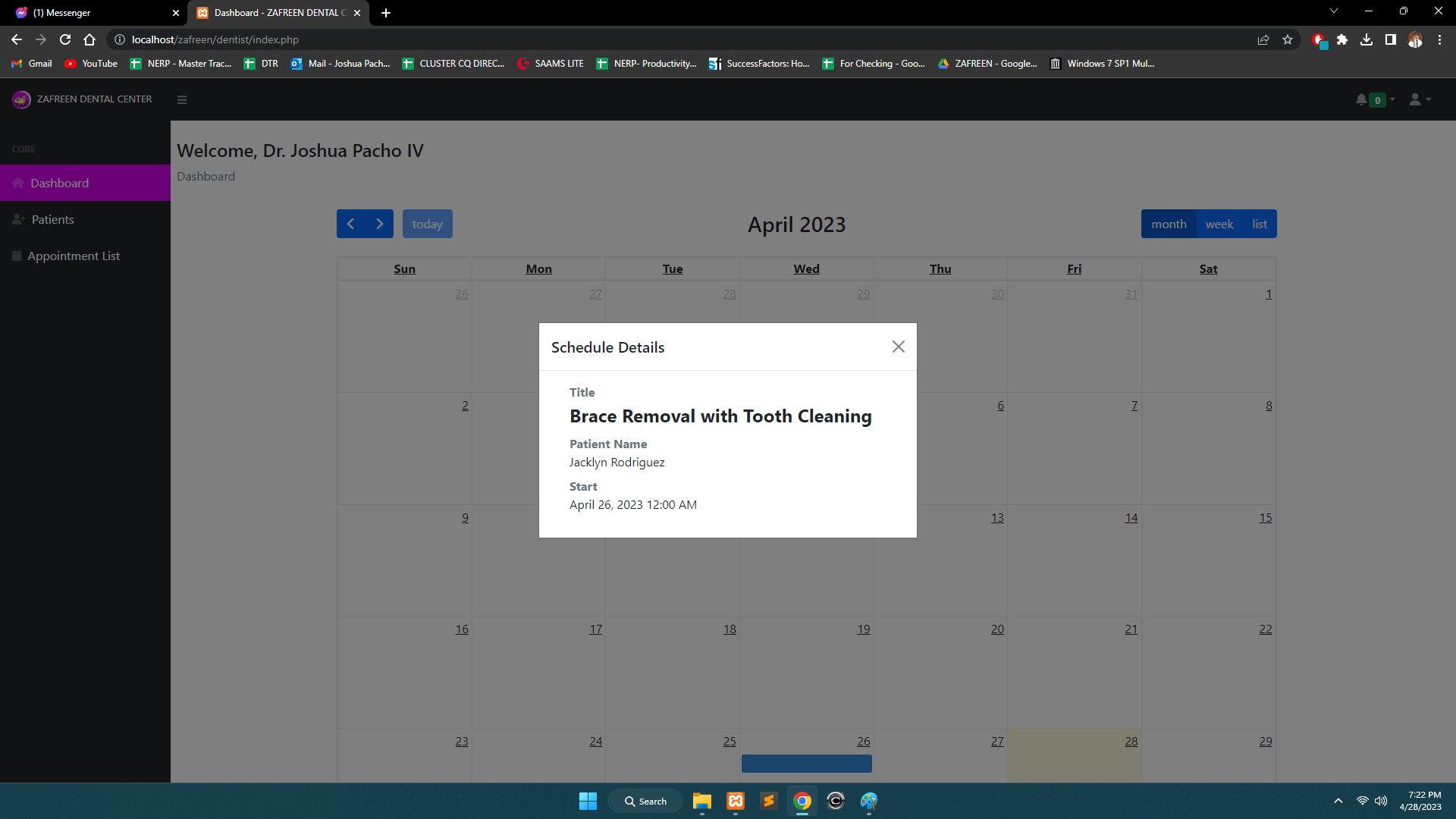
Security Considerations
In the world of healthcare, data security is paramount. Your Dental Management System (DMS) houses sensitive patient information, including medical history, treatment details, and potentially even dental X-rays. Ensuring the security of this data is not just an option, it’s a legal and ethical obligation.
HIPAA Compliance: A Top Priority
The Health Insurance Portability and Accountability Act (HIPAA) is a federal regulation in the United States that sets standards for protecting patient privacy. If your dental practice operates in the US, HIPAA compliance is essential. Here’s how your PHP-based DMS can contribute:
- Secure Storage: Patient data should be stored in a secure database using encryption techniques.
- Limited Access: Implement user authentication and access control mechanisms. Only authorized staff should be able to access patient information, and their access level should be based on their specific role (dentist, hygienist, receptionist). The system should ideally log user activity to track data access attempts.
- Transmission Security: When transmitting patient data between the DMS and other systems (e.g., labs), ensure secure protocols like HTTPS are used to encrypt communication.
Beyond HIPAA: Building a Culture of Security
While HIPAA compliance is crucial, it’s just one piece of the puzzle. Here are some additional security considerations:
- Regular Backups: Implement a regular data backup routine to a secure offsite location in case of hardware failure or cyberattacks.
- Software Updates: Keep your PHP codebase, web server, and database software updated with the latest security patches to address potential vulnerabilities.
- Staff Training: Educate your staff on data security best practices, including password hygiene and being cautious about suspicious emails or phishing attempts.
By prioritizing security throughout the development and operation of your DMS, you can build trust with your patients and ensure their health information remains confidential. Remember, security is an ongoing process, not a one-time fix. Regularly review and update your security measures to stay ahead of evolving threats.
Conclusion
In this blog post, we explored the significance of Dental Management Systems (DMS) and the advantages of using PHP for building such systems. Let’s recap the key points discussed and emphasize the importance of DMS in streamlining dental practice management:
- Key Points Recap:
- Dental Management Systems are comprehensive software solutions designed to automate and streamline various aspects of dental practice management, including appointment scheduling, patient record keeping, billing, and inventory management.
- PHP, with its flexibility, rich ecosystem, and web-based accessibility, is an ideal choice for building Dental Management Systems. PHP allows for easy customization, scalability, and integration with other technologies, making it well-suited for meeting the unique needs of dental practices.
- We discussed the development process of a Dental Management System in PHP, including setting up the development environment, database design, user interface and functionality development, and security considerations.
- Importance of Dental Management Systems:
- Dental Management Systems play a crucial role in streamlining dental practice management by automating administrative tasks, improving operational efficiency, and enhancing patient care.
- By centralizing patient records, appointment scheduling, billing, and inventory management, DMS enable dental practices to optimize workflow, reduce errors, and enhance overall practice efficiency.
- Moreover, DMS ensure compliance with regulatory requirements, such as HIPAA, by implementing robust security measures to protect patient privacy and safeguard sensitive information.
- Encouragement to Explore PHP’s Capabilities:
- We encourage readers to explore PHP’s capabilities and consider developing their own Dental Management System. PHP offers a versatile and powerful platform for building custom solutions tailored to the specific needs and workflows of dental practices.
- By leveraging PHP’s flexibility, developers can create efficient, user-friendly, and secure DMS solutions that streamline practice operations, improve patient care, and drive practice success.
In conclusion, Dental Management Systems built with PHP offer dental practices a powerful tool for optimizing practice management, enhancing patient care, and ensuring regulatory compliance. By harnessing PHP’s capabilities and embracing the development of custom DMS solutions, dental practices can achieve greater efficiency, productivity, and patient satisfaction.
Credits to the developer of the project:
Readers are also interested in:
Dental Clinic System Database Project
Medical and Dental Record System User Interface and Features
You may visit our Facebook page for more information, inquiries, and comments. Please subscribe also to our YouTube Channel to receive free capstone projects resources and computer programming tutorials.
Hire our team to do the project

